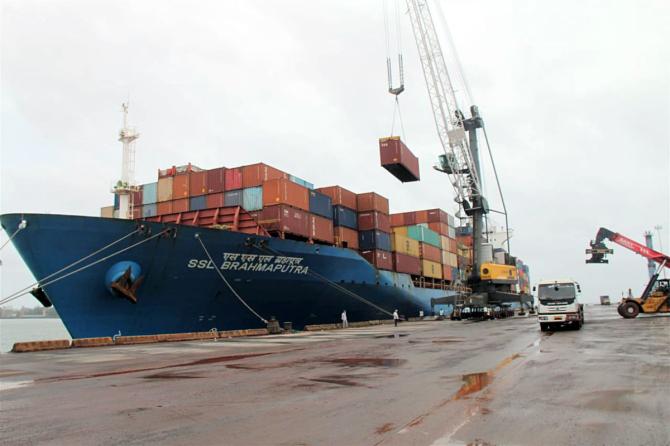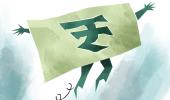'Rhetoric and chest-thumping are running high on India's recent growth record.'
'But will the giant waves developing elsewhere allow us to sail smoothly into fair winds?' asks Debashis Basu.

For the past four months, a strong rally has gripped the Indian market, while the US stock market has been on a huge bull run throughout this year.
Investors have shrugged off macroeconomic problems such as high interest rates, poor economic growth, and very high debt levels in the developed world.
And yet, having declared victory over inflation in the US, which was the main bugbear of 2022, investors appear to be having second thoughts about whether the problems are really over.
Indeed, various parts of the world economy could perhaps throw up some nasty surprises.
Let's take a look.
China
Let's start with China, whose GDP growth in 2022 was just 2.9 per cent, mainly because of draconian measures to control COVID-19.
In December, when China lifted Covid restrictions due to public protests, there was a global consensus that growth would surge.
'China reopening proved to be a mirage. Several reports reveal that China has serious problems.
In July, consumer prices declined for the first time in over two years, while exports plunged by 14.5 per cent year-on-year; this is the third month of continuous decline.
China's exports to the US, its biggest market, fell by a staggering 23 per cent, while exports to the European Union were down 20.6 per cent.
China's exports and imports collectively make up 40 per cent of its economic output.
A big chunk of its imports go into manufacturing products for export, so when China's exports drop, its imports also decline, which could have a devastating effect on jobs and incomes in the country.
Manufacturing activity contracted for four straight months and the unemployment rate among China's youth was 21 per cent in May.
A continuous fall in prices is technically known as deflation.
Deflation is a killer for heavily indebted countries like China because debt repayment increases.
China's national debt is now estimated at 282 per cent of national output -- more than that of the US.
A large part of the debt is due to wasteful infrastructure projects and real estate.
China's real estate market, which represents 30 per cent of Chinese GDP, is in slow-motion crash.
The majority of Chinese property developers are in default of their dollar bonds.
Worryingly, a lot of issues that China will face are long-term, including the deep impact of its single child policy of the past.
Over the past decade, China has delivered more than 40 per cent of global economic growth, according to BCA Research.
If China faces deflation, there would be new economic realities to address.
Through a lower cost of exports, it may help to curb inflation but it would put local manufacturers in many countries on the mat, increasing unemployment there.
Protectionism would rise even more. US President Joe Biden referred to China's economy as 'a ticking time bomb', adding: 'When bad folks have problems, they do bad things.'
India's imports from China have been galloping, widening our current account deficit. It would get worse.

US
While China faces deflation, the US is struggling to control inflation despite 11 rate hikes between March 2022 and now.
The latest data shows inflation remains untamed for shelter, services, and wholesale prices.
The US is also going through an extraordinary debt binge.
It added $8 trillion to its debt in three years, of which $1.5 trillion has been added since the debt ceiling crisis last May.
The US will soon pay over $1 trillion in interest per year, but tax revenue is down around 8 per cent over the past 12 months.
Its Budget deficit has doubled to $1.6 trillion for the first 10 months of the financial year (which ends on September 30).
Consequently, the rating agency Fitch has downgraded the US government's top credit rating to AA+ from AAA.
In Fitch's view, 'There has been a steady deterioration in standards of governance over the last 20 years, including on fiscal and debt matters'.
The effect on debt and higher interest rates on consumers has been worrying.
US homeowners are now spending a record 40 per cent of their gross income on their mortgage.
This is higher than the 2008 peak of 39 per cent.

Japan
If China is going the Japan way, what is happening in Japan?
After decades of price stability, there is now 3.3 per cent inflation in Japan, caused by higher prices of food, fuel, and durables.
A lot of the inflation is imported, as the yen has plunged against the dollar.
The Bank of Japan (BoJ) abandoned its hard cap on 0.5 per cent on the government bond yield, a decision that has shaken up the financial world.
The new cap is 1 per cent. The day the BoJ upped its yield cap, US bond yields jumped, hitting their highest level since November last year.
The US treasury is set to ramp up its new long-dated bond issues, putting further upward pressure on yields.
A higher yield in US treasury bills is like an uncontrolled wrecking ball.
The bond and forex markets are digesting these implications.
They will eventually set the direction for equity markets.
Where does India figure in this jigsaw?
India's exports are uncompetitive due to high infrastructure cost, poor productivity, friction in doing business, vexatious laws, poor governance, and a slow and expensive justice system.
Note that China's export loss has been Vietnam's and Mexico's gain, not India's.
That is why India has a widening current account deficit, which needs to be funded by foreign capital.
While domestic growth has been robust in the post-Covid period, a lot of it is due to massive government spending on defence, railways, and infrastructure.
Even with a spending boost, India's capital goods segment grew only 2.2 per cent this June, consumer durables output fell 6.9 per cent, and the output of consumer non-durable goods increased a mere 1.2 per cent.
Rhetoric and chest-thumping are running high on India's recent growth record.
But will the giant waves developing elsewhere allow us to sail smoothly into fair winds? We will know soon.
Debashis Basu is editor of moneylife.in and a trustee of the Moneylife Foundation.
Feature Presentation: Aslam Hunani/Rediff.com











